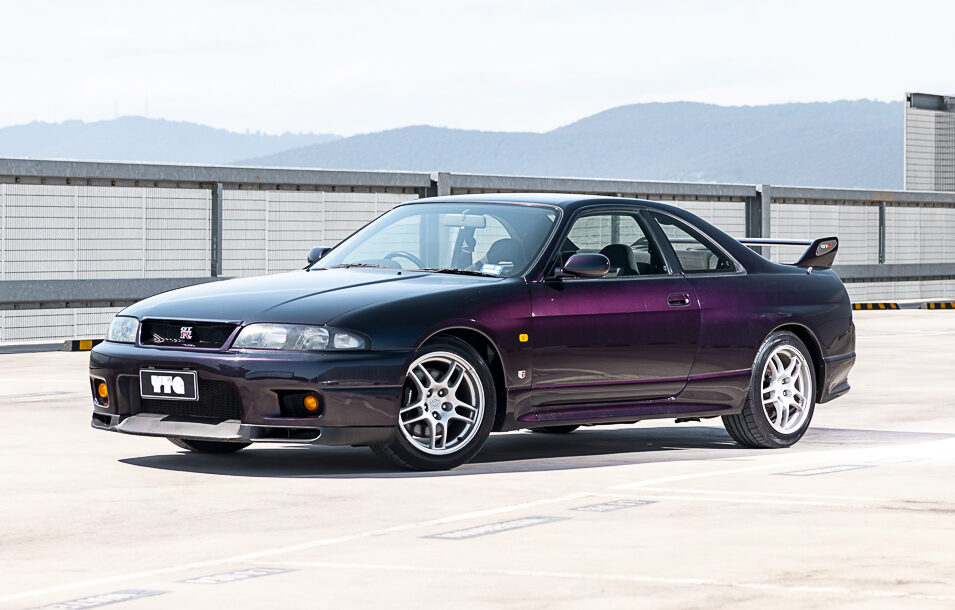With the release of a HSV with one eye toward the race track, we thought it fitting to take it to the greatest track of all.
This year the race for Bathurst glory began on the same day Ford killed the Aussie Falcon. Cameron Kirby took HSV’s new Clubsport Track Edition to the spiritual home of Ford and Holden’s rivalry to discover whether passion trumped pathos
It’s 8:45am on Friday, October 7, and I’m at Tullamarine to collect snapper Wielecki for our bittersweet roadtrip. This will be my first big drive in an HSV, and not just any model but the newly minted Clubsport Track Edition, complete with bigger brakes, a more responsive engine and racier suspension, making it the most track-focused HSV to date. Perfect for a blast to the greatest race track in Australia, Mount Panorama.
Bittersweet because my first drive in an HSV could also be my last.
It’s not my fault I was born in 1993, six years after HSV began, or that I only got my licence as HSV celebrated its 23rd anniversary, when the 375kW W427 was already two years old. And I’m definitely not to blame for getting to Wheels just two years before Holden stops building Commodores, leaving HSV with nothing but imports to fettle.

The mission is to spank the Track Edition from Melbourne to Bathurst in time for The Great Race. We’ll avoid the straight-n-drowsy Hume and find every backroad possible to test the Track’s honed abilities. But we’ve only got a day to get there because the other half of our mission is to sample the mood on The Hill.
Coincidence or not, Ford Australia has chosen to close its Broadmeadows and Geelong assembly plants on the same day that the V8s hit Mount Panorama for qualifying. And Wheels wants to know what Australia’s most passionate tin-top fans think about our big Aussie cars departing this wide brown land. Cars that were so much a part of our culture, our national identity, have withered from consumer neglect to the point where they’re no longer production viable.
The death knock. Does the average bloke on The Hill care? Does his wife, his family, his friends?
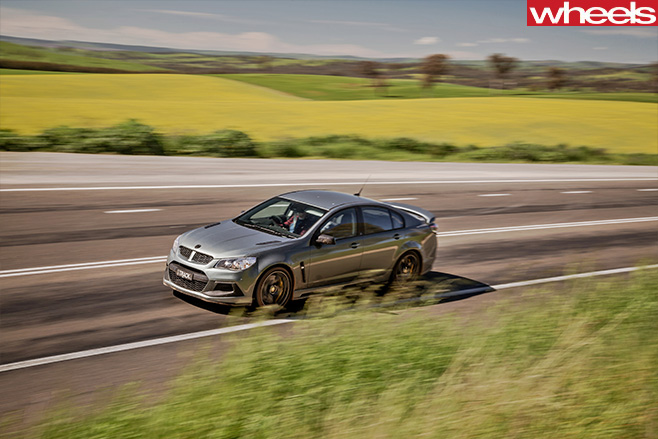
At 10.30am, just as the last Falcon has completed its journey to the very end of the Broadmeadows production line, we peel off the Hume Highway for Shepparton… and say hello to Ian Griffith, a fifth-generation canola farmer from a family whose history of working this land stretches back three-times’ the Falcon’s measly 56 years. While Wielecki puts the Prussian Steel Clubsport among the sunshine yellow canola fields, I take Ian’s Falcon pulse.
“It is a real shame that Ford is closing down,” he says with a sigh, leaning against one of the trailers of his B-double. “Back in the ’60s and ’70s everyone would get a fair wage and the bosses still earned money. Now it’s all cut-throat. Every penny counts.”
Ian fits your typical image of a farmer. Weathered, calloused hands from time toiling the soil; a deeply furrowed brow tells me he’s knows a hard day’s work.

While it would be easy to listen to more of Ian’s musings, the Mountain is calling, so we push north into Jerilderie, once the fertile poaching ground for another Australian legend, Ned Kelly.
Unlike that stovepipe-wearing bushranger, the HSV Track Edition’s visual changes are subtle: blacked-out badges and a lack of signage on the bootlid. Inside, there are Track Edition plaques on the door sills and below the shifter. The most obvious tactile adjustment over the standard R8 is an Alcantara-clad wheel. The wheel stands out as a highlight, and a feature HSV should put on the options list for its other vehicles.
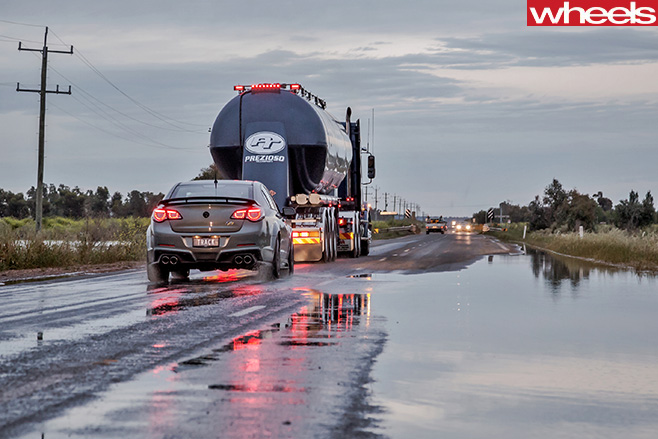
Despite the lack of a blower, the Track Edition still sings a fine tune, letting out a sharp bark at start-up, and crackling nicely off the throttle. However, it’s a sad day when a company puts a ‘sound enhancer’ (which feeds extra engine noise into the cabin) on a car with a 6.2-litre V8. At least it isn’t artificially enhanced through the Bose speakers inside the cabin.
The other Track Edition changes are hidden inside shiny 20-inch wheels from the GTS; 390mm two-piece brake discs up front and 367mm drilled single-piece discs in the rear are grasped by forged six-piston AP Racing calipers previously reserved for the HSV GTS flagship. The imposing set-up scrubs off speed forcefully, but despite their considerable stopping power won’t put your face through the windshield every time you think of slowing down. There’s great feedback through the pedal.
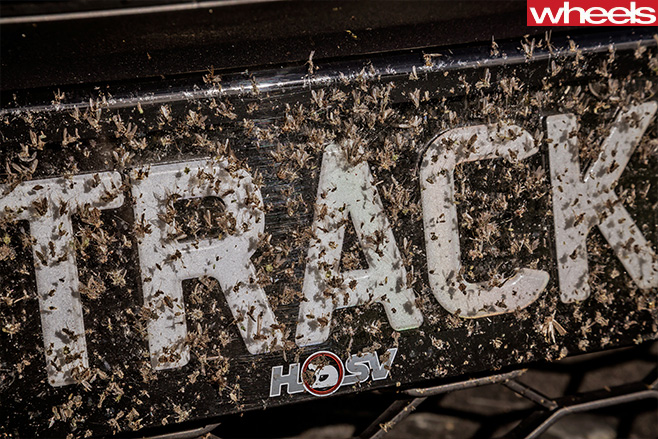
Still, it eats the miles easily; coupling cruise control with the heads-up display means that keeping track of speed on the straight sections of road to Griffith is easy, keeping me on the right side of the boys in blue.
The rivers here have swollen to breaking point after weeks of heavy rain, the vast plains now drenched and flooded. An onslaught of mosquitoes of horror-flick proportions is so thick that it sounds like we’re driving through rain as they splatter across the grille for the last 50km into Griffith.
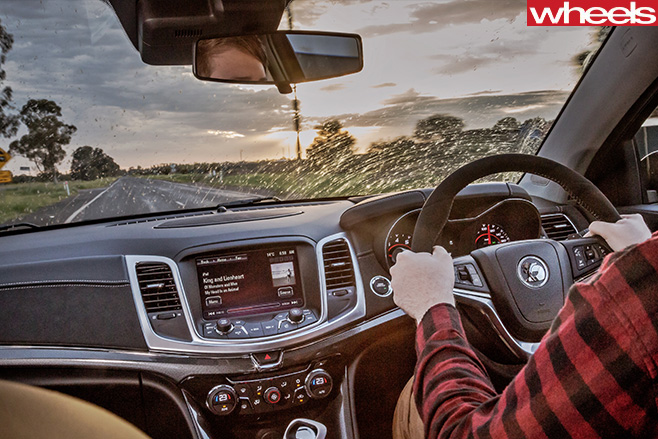
We stop for breakfast in Ardlethan, a sleepy little town with a café, newsagent and general store all rolled into one. As we speak with shopkeeper Sophie, her mother Leanne and stepfather Glen arrive with son Zacariah. Interest turns to the HSV parked outside. Cars like this don’t often roll through Ardlethan. A rev of the V8 for young Zac brings more locals out from the woodwork; the HSV is a major attraction. A few quick laps of the main drag demonstrate the Track Edition’s impressive speed and roar. Performance mode means the ESP and traction control give enough slip to feel like a hero but stops you from becoming a zero with a bent car. It’s smiles all around in the cabin.
However, this tighter, more ‘track-focused’ HSV does have its weaknesses. On undulating country highways the stiffer suspension means you become acutely aware of every ounce of fat on your body. The car jiggles constantly, those nestled in the leather-clad seats never able to settle. I realise it’s time to start a diet.
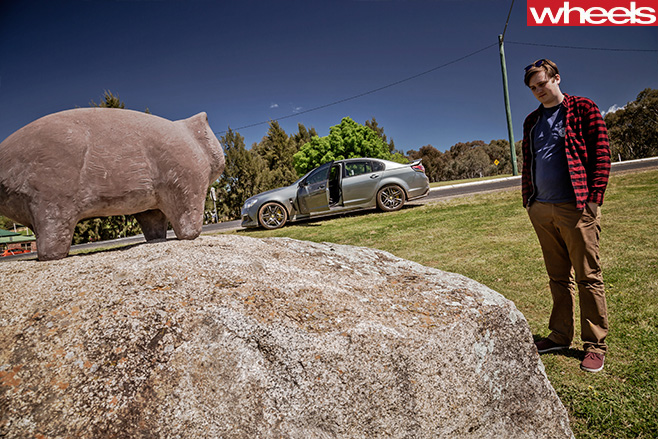
But when we reach Cowra I begin to feel the hype of Bathurst. The Mountain is still 100km off, but its presence can be felt. Outside a pub sits an E-Series HSV and a VL Walkinshaw SS – it’s a family reunion of sorts. There’s also an increased police presence; all eight highway patrol cars we pass during the trip are located in this final section of road.
The significance of the trip begins to sink in. Here I am driving one of the last Aussie V8s to the most sacred piece of bitumen in Australia, a place where legends are made and childhood dreams realised. And on the weekend that marks 10 years since Peter Brock’s death as well as the Falcon’s end. It would be a fine time to become emotional if I wasn’t so excited.
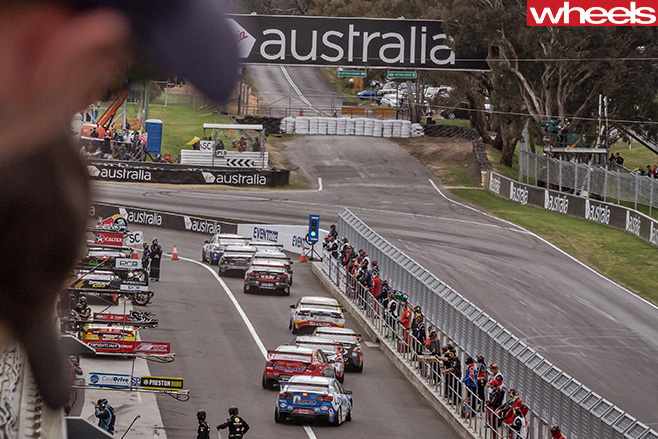
For many, camping at the Bathurst 1000 is a ritual, something that’s been done for generations. Most just pitch tents, others haul caravans or drive motorhomes, making the campground like any other. But the larger groups band together, constructing temporary structures, which turn into makeshift bars, a central hub for their merry crews. These are the veterans who have been coming for decades, and lay claim to the prime camping positions.
One, located directly opposite the McPhillamy Park section of track, is easily identifiable thanks to a huge banner draped across the front: Wobbly Boot Bowling Club. Fifty or more patrons wear matching shirts, with the Southern Cross across the chest and a tribute to Peter Brock on the back.
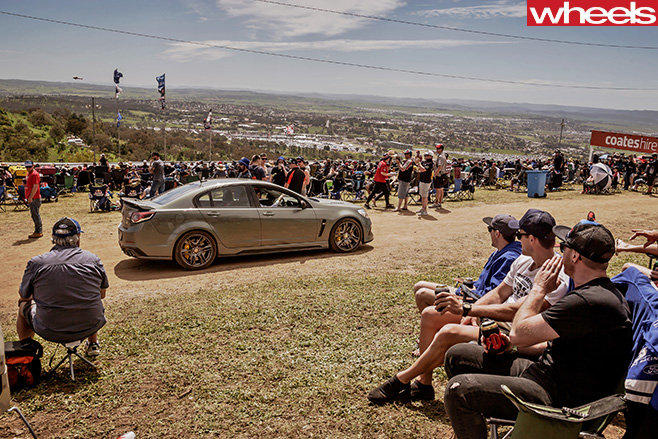
“That free trade agreement killed us,” chimes another. Which free trade agreement he means is unclear, but he’s certainly unhappy about it.
Despite the name, the Wobbly Boot Bowling Club doesn’t actually play Lawn Bowls. Nor do they watch the racing. Instead of walking 10 metres for a clean line of sight of one of the best bits of race track in the world, they sit, drink slushies, crush tinnies and heckle anyone who crosses their path.
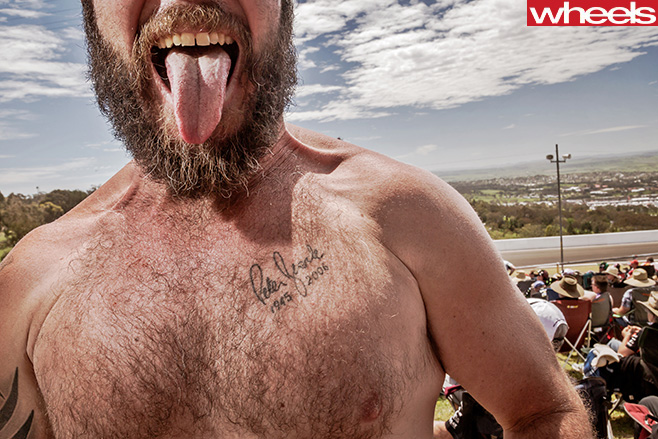
But there is also patriotism to be found in the moment. “It gives you pride that the last Ford engine was put in manually, and that it was the Barra [in-line six]. Aussie men putting in an Aussie engine, the good ol’-fashioned way. A proper send-off”.
Not everyone is torn up about the death of local car manufacturing. Drew has travelled from Newcastle and wears a shirt that lists every year he has been trackside for The Great Race, dating back to 1992. The topic of Broadmeadows closing brings a simple shrug of the shoulders as he holds a sausage sanga in one hand and BBQ sauce stains his shirt. He can’t stand still, constantly shifting his weight. “Yeah, it’s sad I guess, but it doesn’t bother me.” He’s here to drink beer and watch cars race. It doesn’t matter what goes on, as long as it’s fast.
Despite rare patches of indifference to the demise of local car manufacturing, there’s an unbridled passion you can only find at Mount Panorama. There are tribute banners and flags, and plenty of tattoos.

“Holden and Ford saved Australia,” he adds after a swig. “Our economy was nowhere in 1942. But then Ford and Holden gave everyone a job. They saved us and what do we do? Kick ’em to the curb! Disgraceful.”
For the Blue Oval faithful, this weekend hurts the most, but watching the race makes things easier. Mike and his mate from Melbourne have been coming for 30 years. They wear matching wigs and shirts. Both Ford men, they say the loss of the Falcon hurts but that a leopard never changes its spots and the company is still revered. “Ford will still be around,” Mike says, searching for the silver lining.
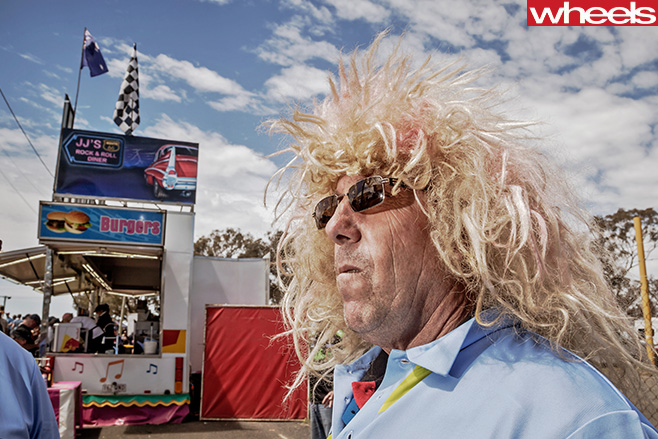
For many fans, there’s a feeling of powerlessness. Yes, they are sad that Broadmeadows has closed, but what can you do? Many bought locally built cars, yet simply don’t have the capacity to get torn up over something they cannot control.
You can’t talk Holden and Ford road cars without bringing up the on-track rivalry. That’s the hardest thing for fans to reconcile. Mike is reluctant to discuss the future of Supercars and the Bathurst 1000. Eventually The Great Race won’t have a Ford Falcon on the grid, or a V8 engine, possibly not even a Commodore. Those years aren’t too far away, and for some that’s a bitter pill to swallow.
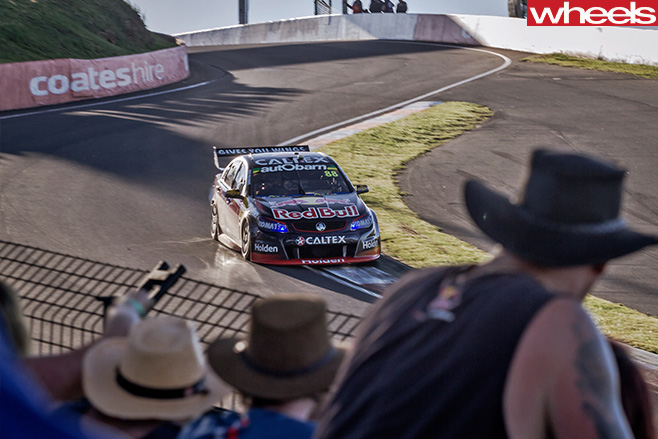
Our tattooed friend sees it differently. “I don’t care! I’ll be here to the day I bloody die!” he bellows to grunts of approval from his mates.
It’s not clear what will replace the Falcon on track, however its been said that the imported Holden Commodore will continue to compete in Supercars, but just don’t expect eight cylinders under the bonnet.
Many fans will soon have to decide whether to keep watching or turn their backs on something they love, with V8s potentially being joined by twin-turbo V6 powerplants in Supercars from next year. Many stayed on when Nissan, Mercedes-Benz and Volvo broke into the exclusive Ford and Holden club, but is the V8 engine sacred ground? Time will tell.

The Mountain doesn’t forgive, and it doesn’t forget. Take note, Holden.
Remembering The King
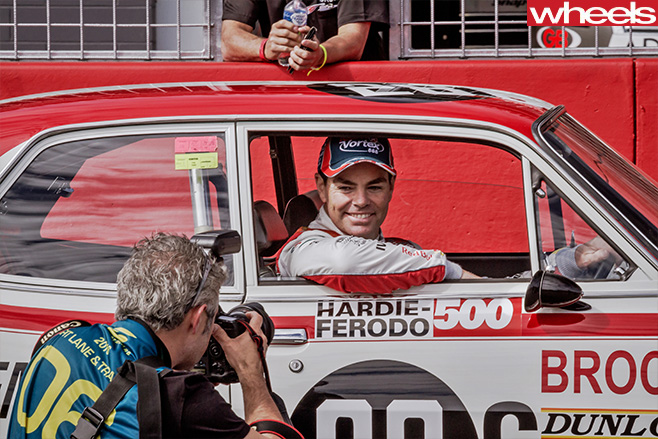
The biggest carpark in Oz
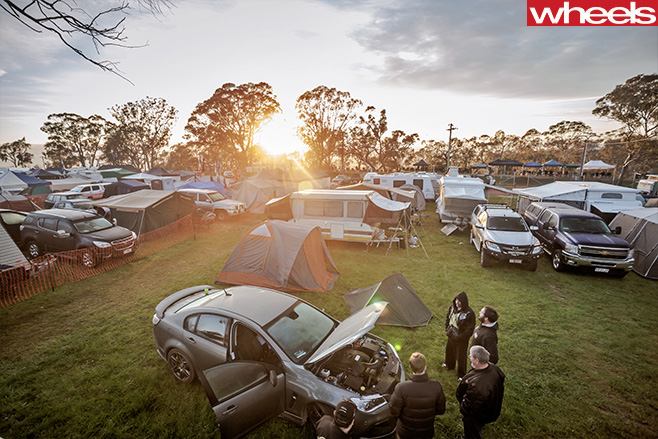
Better the evil you know
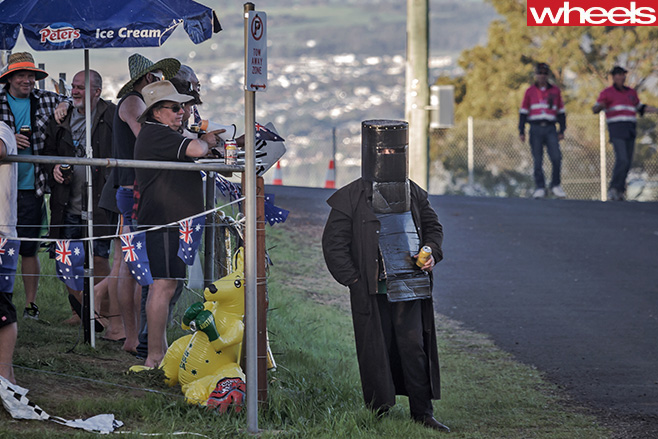
SPECS Model: HSV Clubsport Track Edition Engine: 6162cc V8, ohc, 16v Max power: 340kW @ 6100rpm Max torque: 570Nm @ 4650rpm Transmission: 6-speed automatic Kerb weight: 1754kg Fuel economy: 12.2L/100km (estimated) 0-100km/h: Sub-5.0sec (claimed) Price: $72,585 On sale: Now




